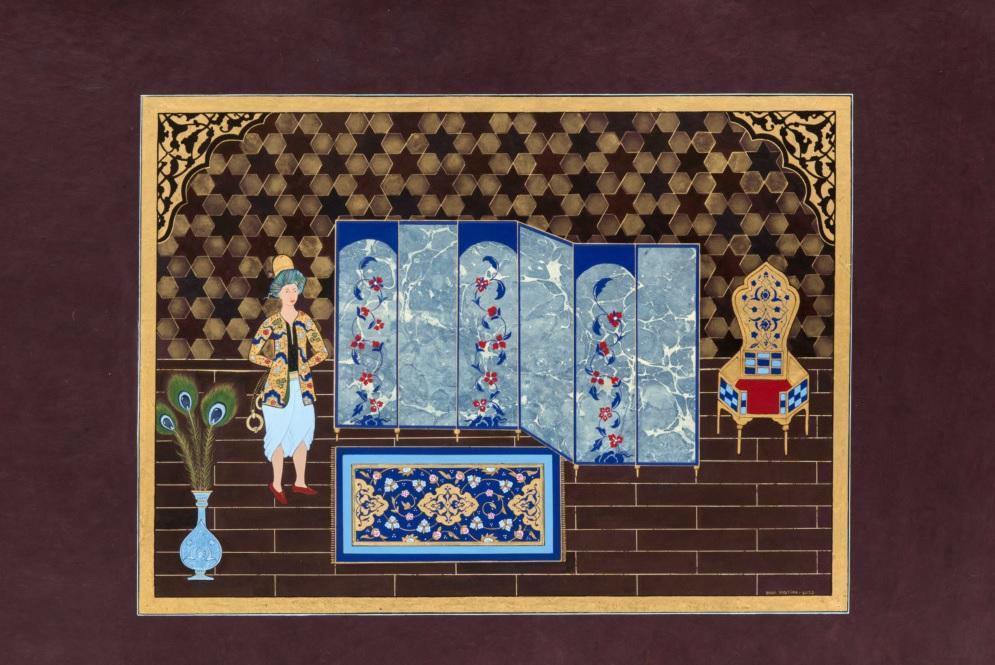Anna Laudel Istanbul presents ‘Echos’
ISTANBUL

Supporting artists with two international gallery spaces, Anna Laudel Istanbul presents “Defragmentology” by German artist Mathias Hornung and “Assimilation” by Turkish artist Onur Hastürk under the title of “Echos.”
Earlier featured at Anna Laudel Düsseldorf in 2020, the two solo shows will now feature at Anna Laude Istanbul, where the artists will reveal their brand new works.
The show “Echos” brings together compelling themes and techniques highlighted by Hornung and Hastürk, diverging from the integration of Islamic painting with contemporary art to the transformation of traditional engraving into digital art.
The title of the exhibition, “Echos,” is derived from the Latin verb “echo,” which means a sound repeated by reflection. Likewise, despite the different techniques used, the two solo exhibitions and the artists together complement each other by establishing a bridge between the past and the present in Turkey, followed by their first presentations in Germany.
'Defragmentology'
Dissolving the boundary between technology and sculpture, Hornung showcases his first solo exhibition at Anna Laudel Istanbul. Hornung draws a bow from the woodcut into the digital world and presents his images thematically and structurally in the confusing present. By doing so, he questions the multi-layered, and at the same time, incalculable dimensions of dealing with information in an irritating way.
Symbolizing different ages, each artwork enlightens itself again. He expands into new possibilities, commonalities, and points of view with wood, paper, and technological devices used in his artworks. In a world of ever more perfect technical images and the medial flood of images, he links their codes with the old process of high pressure with his direct manual access to sensual immediacy, corporeality and haptics.
Artworks based on rectangular grids printed either on paper or three-dimensionally on the wood are sensual, and at the same time, conceptual images that play with the space and interspace between media and materials. In his woodblock prints, Hornung presents the past, present, and future’s oscillating relationship. Topography, as well as, time and space, play an important role in his works, but the ultimate idea behind his works is the break from the perfect, even and regular web of life.
'Assimilation'
Recognized by his combined style of Islamic painting and design with contemporary art, Hastürk meets with art lovers with his first solo show at Anna Laudel Istanbul.
Welcomed in Europe with his debut solo exhibition in Düsseldorf, Hastürk pulls the numerous artistic cultures of Islam freely and places them in new conversations with the art of the modern West -- from Henri Matisse to Andy Warhol.
Within the exhibition, Hastürk presents his works within three compelling series: “Respect to Matisse,” “Respect to Warhol” and “Classical Miniature.”
The “Respect to Matisse” series is a contradiction produced between modern and traditional art. Matisse’s paintings include the naturalism and tactility of the European painting tradition, rhythmic patterns of Islamic carpets, and the shallow compositional areas of Islamic miniature painting. His work doubles as Islamic art’s returning gaze on Matisse’s Islamic-inspired modernism, where the nameless Islamic artists are eclipsed by Matisse’s breakthrough.
Like Matisse’s paintings, Warhol’s canvases and ready-made sculptures reflect Hastürk’s practice. In 1957, Warhol published “A Gold Book,” a bound volume of 19 offset lithograph prints depicting flowers, high-fashion shoes and magazine models, most of which were printed on gold paper. Hastürk engages with a different dimension of Warhol’s oeuvre in the series “Respect to Warhol” and explores the impact of the artist’s figures and his attraction to gold with Islamic art practices.
In the Classical Miniatures series, Hastürk presents the miniature’s potential for both dynamic aesthetic experimentations and the representation of modern subjectivity. He shows the extraordinary properties of İznik Tile’s, which modernists, such as Henri Matisse, admired.
“Echos” and a special selection of artworks showcased at the virtual art fair can be visited by making reservations until Feb. 28.
















